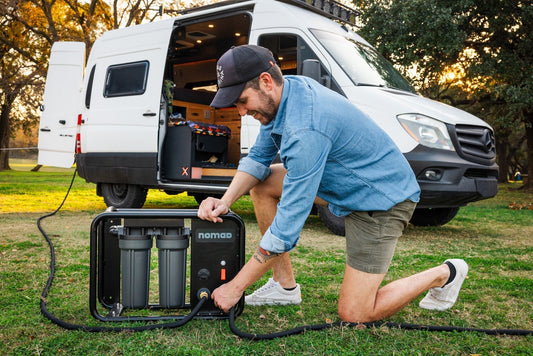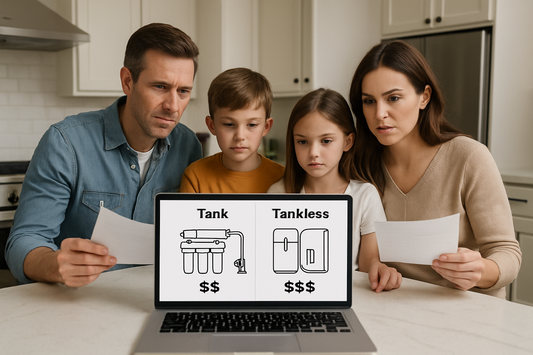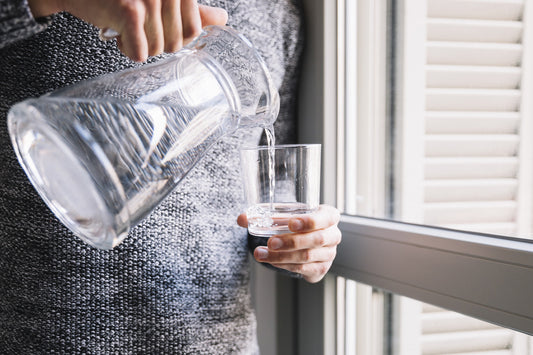When your kitchen faucet barely trickles water or your drinking water suddenly tastes like chlorine, your under-sink filter is crying for help. The good news? Most filter problems take just 15 minutes to fix with a simple cartridge replacement. Here's how to change water filter cartridge under sink systems quickly and avoid the most common mistakes that leave homeowners frustrated.
Warning Signs Your Under-Sink Filter Needs Immediate Attention
Your filtration system communicates problems through clear signals that most homeowners miss until it's too late.
Water Pressure Has Dropped Dramatically
When your once-powerful faucet becomes a gentle drip, sediment buildup inside the filter cartridge is choking water flow. This happens faster in areas with hard water or high sediment content.
Strange Taste or Odor Returns
If your water tastes metallic, smells like chlorine, or has an odd aftertaste, the activated carbon in your filter has reached capacity and can no longer remove contaminants effectively.
Visible Particles in Your Water
Cloudy water or floating particles indicate your filter has failed completely. Don't ignore this – contaminated water poses serious health risks.

Image by Antares_NS
How to Change Water Filter Cartridge Under Sink: Complete Process
What You'll Need
- Filter wrench (specific to your housing type)
- New replacement cartridge
- Large bucket or basin
- Clean towels
- 15 minutes of your time
Step 1: Shut Off Your Water Supply (2 minutes)
Locate the cold water shutoff valve under your sink – usually a small handle near the back wall. Turn it clockwise until it stops. This prevents flooding during the replacement process.
Step 2: Release System Pressure (1 minute)
Press the pressure release button on your filter housing (typically red or black). You'll hear a brief hissing sound as trapped pressure escapes. Skip this step and water will spray everywhere when you open the housing.
Step 3: Position Your Catch Basin (30 seconds)
Place your bucket directly under the filter housing. Even with proper preparation, some water spillage is normal.
Step 4: Remove the Old Filter Housing (3 minutes)
Using your filter wrench, turn the housing counterclockwise. Pro tip: If it's stuck, wrap a towel around the wrench for better grip. Remove the old cartridge and inspect the housing for cracks or damage.
Step 5: Clean and Install New Filter (5 minutes)
Rinse the housing with clean water to remove sediment buildup. Check that the O-ring seal is properly seated – this prevents leaks. Insert your new cartridge, ensuring it sits flush at the bottom.
Step 6: Reassemble and Test (3 minutes)
Hand-tighten the housing first, then use the wrench to secure it. Turn your water supply back on slowly and check for leaks. Run water for 2-3 minutes to flush any loose carbon particles.

Image by amixstudio
Understanding When Your Filter Actually Needs Replacement
Most manufacturers recommend six-month replacement cycles, but real-world usage varies dramatically. Households using well water or living in areas with heavy sediment may need monthly changes, while city water users might extend to eight months safely.
Track these indicators instead of calendar dates:
- Water flow rate compared to when filter was new
- Any change in taste or smell
- Visible sediment in filtered water
Advanced Filter Technology: Beyond Basic Carbon
While standard activated carbon filters handle chlorine and basic contaminants effectively, many homeowners discover they need more comprehensive filtration.
When to Consider Upgrading Your System
If you're dealing with heavy metals, fluoride, or bacterial contamination, basic under sink water filter replacement won't solve your problems. Crystal Quest multi-stage systems offer superior filtration with longer-lasting cartridges that save money over time.
Pelican vs. Modern Alternatives
While Pelican Water Systems built a strong reputation for whole house filtration, their under-sink options have become harder to find. Many former Pelican users now choose Crystal Quest or Waterdrop systems for more reliable availability and comparable performance.

Troubleshooting Common Filter Problems
Low Water Pressure After Installation
If pressure remains low after replacement, check that the new cartridge is properly seated and the housing is hand-tight before using the wrench.
Leaking Around the Housing
O-ring problems cause 90% of filter leaks. Remove the housing, clean the O-ring groove, and ensure the rubber seal isn't twisted or damaged.
Black Particles in Water
New carbon filters often release harmless carbon dust. Run water for 5 minutes – if particles persist, the cartridge may be defective.
Maintaining Your System for Maximum Performance
Monthly: Check for visible leaks around connections Quarterly: Monitor water flow rate and taste Bi-annually: Replace standard cartridges or as needed based on usage
Regular maintenance prevents emergency failures and ensures your family always has access to clean, safe drinking water.
FAQ Section
How often should I really replace my under-sink water filter cartridge?
Replace cartridges every 6 months for average households, but monitor water pressure and taste changes. High-usage homes or poor water quality may require more frequent changes.
Can I change the water filter myself without calling a plumber?
Yes, under-sink filter replacement is designed for homeowners. The process takes 15 minutes with basic tools and doesn't require plumbing expertise or permits.
Why does my water taste worse after installing a new filter?
New carbon filters release harmless particles initially. Run water for 5 minutes to flush the system. If taste problems persist, the cartridge may be defective.
What's the difference between basic and advanced under-sink filtration systems?
Basic systems use activated carbon for chlorine and taste improvement. Advanced systems like reverse osmosis remove heavy metals, fluoride, and bacteria for comprehensive purification.






